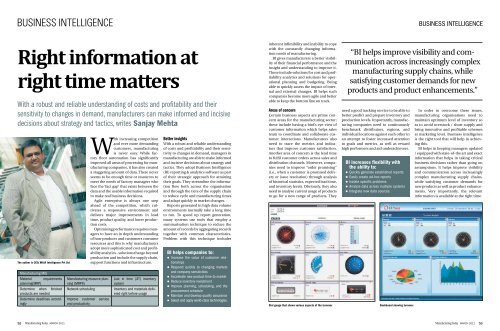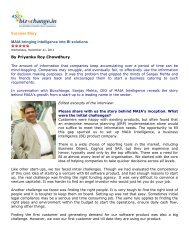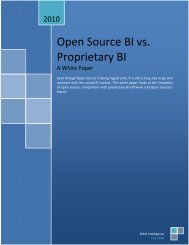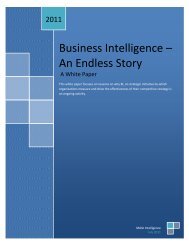Right information at right time matters
for Manufacturing - MAIA Intelligence
for Manufacturing - MAIA Intelligence
- No tags were found...
You also want an ePaper? Increase the reach of your titles
YUMPU automatically turns print PDFs into web optimized ePapers that Google loves.
Business Intelligence<br />
Business Intelligence<br />
<strong>Right</strong> <strong>inform<strong>at</strong>ion</strong> <strong>at</strong><br />
<strong>right</strong> <strong>time</strong> m<strong>at</strong>ters<br />
With a robust and reliable understanding of costs and profitability and their<br />
sensitivity to changes in demand, manufacturers can make informed and incisive<br />
decisions about str<strong>at</strong>egy and tactics, writes Sanjay Mehta<br />
The author is CEO, MAIA Intelligence Pvt Ltd<br />
Manufacturing MIS<br />
M<strong>at</strong>erial requirements<br />
planning(MRP)<br />
Determine when finished<br />
products are needed<br />
Determine deadlines accordingly<br />
Manufacturing resource planning<br />
(MRPII)<br />
Network scheduling<br />
Improve customer service<br />
and productivity<br />
With increasing competition<br />
and ever more demanding<br />
customers, manufacturing<br />
is never easy. While factory<br />
floor autom<strong>at</strong>ion has significantly<br />
improved all areas of processing for manufacturing<br />
companies, it has also cre<strong>at</strong>ed<br />
a staggering amount of d<strong>at</strong>a. There never<br />
seems to be enough <strong>time</strong> or resources to<br />
meet the needs of factory managers who<br />
face the ‘fact gap’ th<strong>at</strong> exists between the<br />
d<strong>at</strong>a and the usable <strong>inform<strong>at</strong>ion</strong> required<br />
to make real business decisions.<br />
Agile enterprise is always one step<br />
ahead of the competition, which cultiv<strong>at</strong>es<br />
a responsive environment and<br />
delivers major improvements in lead<br />
<strong>time</strong>, product quality, and lower production<br />
costs.<br />
Optimising performance requires managers<br />
to have an in depth understanding<br />
of how products and customers consume<br />
resources and this is why manufacturers<br />
adopt more sophistic<strong>at</strong>ed cost and profitability<br />
analytics - solutions th<strong>at</strong> go beyond<br />
production and include the supply chain,<br />
support functions and infrastructure.<br />
Just in <strong>time</strong> (JIT) inventory<br />
system<br />
Inventory and m<strong>at</strong>erials delivered<br />
<strong>right</strong> before usage<br />
Better insights<br />
With a robust and reliable understanding<br />
of costs and profitability and their sensitivity<br />
to changes in demand, managers in<br />
manufacturing are able to make informed<br />
and incisive decisions about str<strong>at</strong>egy and<br />
tactics. They adopt Business Intelligence<br />
(BI) reporting & analytics software as part<br />
of their str<strong>at</strong>egic approach for <strong>at</strong>taining<br />
their goals. They streamline the <strong>inform<strong>at</strong>ion</strong><br />
flow both across the organis<strong>at</strong>ion<br />
and through the tiers of the supply chain<br />
to reduce cycle and manufacturing <strong>time</strong>s<br />
and adapt quickly to market changes.<br />
Reports gener<strong>at</strong>ed in high d<strong>at</strong>a volume<br />
environments normally take a long <strong>time</strong><br />
to run. To speed up report gener<strong>at</strong>ion,<br />
many systems use tools th<strong>at</strong> employ a<br />
summaris<strong>at</strong>ion technique to reduce the<br />
amount of records by aggreg<strong>at</strong>ing records<br />
together with common characteristics.<br />
Problem with this technique includes<br />
BI helps companies to:<br />
• Increase the value of customer rel<strong>at</strong>ionships<br />
• Respond quickly to changing markets<br />
and company sensitivities<br />
• Acceler<strong>at</strong>e new product <strong>time</strong>-to-market<br />
• Reduce inventory investment<br />
• Improve planning, scheduling, and the<br />
procurement schedule<br />
• Maintain and develop quality assurance<br />
• Select and apply world-class technologies.<br />
inherent inflexibility and inability to cope<br />
with the constantly changing <strong>inform<strong>at</strong>ion</strong><br />
needs of manufacturing.<br />
BI gives manufacturers a better visibility<br />
of their financial performance and the<br />
insight and understanding to improve it.<br />
These include solutions for cost and profitability<br />
analytics and solutions for oper<strong>at</strong>ional<br />
planning and budgeting. Being<br />
able to quickly assess the impact of internal<br />
and external changes, BI helps such<br />
companies become more agile and better<br />
able to keep the bottom line on track.<br />
Areas of concern<br />
Certain business aspects are prime concern<br />
areas for the manufacturing sector;<br />
these include having a bird’s eye-view of<br />
customer <strong>inform<strong>at</strong>ion</strong> which helps sales<br />
team to coordin<strong>at</strong>e and collabor<strong>at</strong>e customer<br />
interactions. Manufacturers also<br />
need to trace the metrics and indic<strong>at</strong>ors<br />
th<strong>at</strong> improve customer s<strong>at</strong>isfaction.<br />
Another area of concern is the lead <strong>time</strong><br />
to fulfil customer orders across sales and<br />
distribution channels. Moreover, companies<br />
need to improve “order promising”<br />
(i.e., when a customer is promised delivery<br />
or issue resolution) through analysis<br />
of historical st<strong>at</strong>istics, expected lead <strong>time</strong>,<br />
and inventory levels. Obviously, they also<br />
need to analyse current usage of products<br />
to go for a new range of products. They<br />
Dial gauge th<strong>at</strong> shows various aspects of the turnover<br />
“BI helps improve visibility and communic<strong>at</strong>ion<br />
across increasingly complex<br />
manufacturing supply chains, while<br />
s<strong>at</strong>isfying customer demands for new<br />
products and product enhancements.”<br />
need a good tracking service to be able to<br />
better predict and prepare inventory and<br />
production levels. Importantly, manufacturing<br />
companies need to continuously<br />
benchmark distributors, regions, and<br />
individual loc<strong>at</strong>ions against each other in<br />
an <strong>at</strong>tempt to foster increased <strong>at</strong>tention<br />
to goals and metrics, as well as reward<br />
high performers and aid underachievers.<br />
BI increases flexibility with<br />
the ability to:<br />
• Quickly gener<strong>at</strong>e established reports<br />
• Easily cre<strong>at</strong>e ad-hoc reports<br />
• Isol<strong>at</strong>e specific problems<br />
• Analyze d<strong>at</strong>a across multiple systems<br />
• Integr<strong>at</strong>e new d<strong>at</strong>a sources.<br />
Dashboard showing turnover<br />
In order to overcome these issues,<br />
manufacturing organis<strong>at</strong>ions need to<br />
maintain optimum level of inventory so<br />
as to avoid overstock / short-supply and<br />
bring innov<strong>at</strong>ive and profitable schemes<br />
<strong>at</strong> marketing level. Business intelligence<br />
is the <strong>right</strong> tool th<strong>at</strong> will help in achieving<br />
this.<br />
BI helps in keeping managers upd<strong>at</strong>ed<br />
/ equipped with st<strong>at</strong>e-of-the art and exact<br />
<strong>inform<strong>at</strong>ion</strong> th<strong>at</strong> helps in taking critical<br />
business decisions r<strong>at</strong>her than going on<br />
assumptions. It helps improve visibility<br />
and communic<strong>at</strong>ion across increasingly<br />
complex manufacturing supply chains,<br />
while s<strong>at</strong>isfying customer demands for<br />
new products as well as product enhancements.<br />
Very importantly, the relevant<br />
<strong>inform<strong>at</strong>ion</strong> is available <strong>at</strong> the <strong>right</strong> <strong>time</strong>.<br />
52 Manufacturing Today march 2011<br />
Manufacturing Today march 2011 53
Business Intelligence<br />
demand an optimal way of decision making<br />
by the manufacturer. Each manufacturer<br />
has its own processes, own tacking<br />
system, order processing and its own<br />
challenges. All this add up to the need of<br />
having effective BI system in place and<br />
providing results out of it. Again there<br />
has been long deb<strong>at</strong>e on the quality of<br />
d<strong>at</strong>a th<strong>at</strong> is available with manufacturing<br />
industry as for most of them they have to<br />
depend on external parties like retailers,<br />
distributors, contractors, suppliers , its<br />
own customers, others. If a proper feed<br />
is given to Supply Chain and Order management<br />
th<strong>at</strong> will definitely ensure deep<br />
customer insight and inventory d<strong>at</strong>a for<br />
better and effective decision making.<br />
Dashboard showing country wise sales report<br />
“Manufacturing organis<strong>at</strong>ions need to<br />
maintain optimum level of inventory so<br />
as to avoid overstock / short-supply and<br />
bring innov<strong>at</strong>ive and profitable schemes<br />
<strong>at</strong> marketing level.”<br />
Decision making<br />
With BI, one can assess cash-management<br />
and monitor oper<strong>at</strong>ional effectiveness<br />
of the payables department to ensure<br />
lowest transaction costs. It is essential for<br />
a manufacturer to identify most profitable<br />
customers, products, and channels,<br />
and understand profitability drivers<br />
across regions, divisions, and profit<br />
centres. This requires a comprehensive<br />
approach which includes improving<br />
inventory management for those products<br />
th<strong>at</strong> consistently fall into backlog<br />
due to a lack of appropri<strong>at</strong>e stock levels.<br />
It is very important for the company to<br />
have visibility into inventory activities to<br />
minimise unnecessary expenditures and<br />
optimise inventory to conserve working<br />
capital. Equally important is having<br />
a detailed visibility into direct and indirect<br />
spending, and identify opportunities<br />
for consolid<strong>at</strong>ion and reduction of<br />
costs. Moreover, the company needs to<br />
continuously monitor price, delivery, and<br />
product quality to determine best - and<br />
worst-performing suppliers. All this is<br />
possible with BI.<br />
BI can be accessed by top management<br />
who need to obtain str<strong>at</strong>egic <strong>inform<strong>at</strong>ion</strong><br />
th<strong>at</strong> can help them decide the future<br />
course of action, help in taking str<strong>at</strong>egic<br />
decisions. Manufacturing industry need<br />
to look out for a solution th<strong>at</strong> can help<br />
it lower lead <strong>time</strong>, help in reducing production<br />
costs, improve product quality,<br />
better tracking and improve customer<br />
s<strong>at</strong>isfaction. It needs to respond quickly<br />
to changing market environments. In the<br />
current environment delivering the key<br />
<strong>inform<strong>at</strong>ion</strong> to the key people has gained<br />
extra importance th<strong>at</strong> can help plan for<br />
production, reduce hidden costs, keep<br />
optimum level of inventory, and maximise<br />
profits.<br />
Changing customer and distributor<br />
requirements, internal oper<strong>at</strong>ions<br />
Understanding change<br />
One of the challenges th<strong>at</strong> manufacturing<br />
industry face is due to changes<br />
in demand. If managers have a proper<br />
understanding of costs and demand,<br />
they can make better decisions. Some of<br />
the manufacturer’s also have a customer<br />
specific costing. Improved Visibility in<br />
Procure to Pay is helpful to optimise the<br />
supply side performance.<br />
Manufacturing companies’ product<br />
portfolios are larger to manage, has large<br />
number of suppliers to negoti<strong>at</strong>e on cost<br />
and quality, maintain huge inventories<br />
which need to be tracked and moved to<br />
meet customer demands. Along with this<br />
there is always a need to analyse / identify<br />
customer need, maintain and improve<br />
customer delight, add customers so as to<br />
remain in business and be profitable. BI<br />
definitely helps in making <strong>right</strong> decisions<br />
to overcome these pressures and helps to<br />
manage and sustain in business in this<br />
complex environments.<br />
The way ahead<br />
BI is very effective for all types of manufacturing<br />
be it process, discrete, or automotive.<br />
It can close the “fact gap” by improving<br />
the availability and delivery of actionable<br />
d<strong>at</strong>a with minimal IT involvement.<br />
BI for manufacturing industry leverages<br />
all the sources of d<strong>at</strong>a available<br />
throughout the manufacturing process<br />
to deliver a holistic view for smart decisions,<br />
based on d<strong>at</strong>a th<strong>at</strong> accur<strong>at</strong>ely<br />
reflects the true st<strong>at</strong>e of the entire manufacturing<br />
process.<br />
54<br />
Manufacturing Today march 2011










